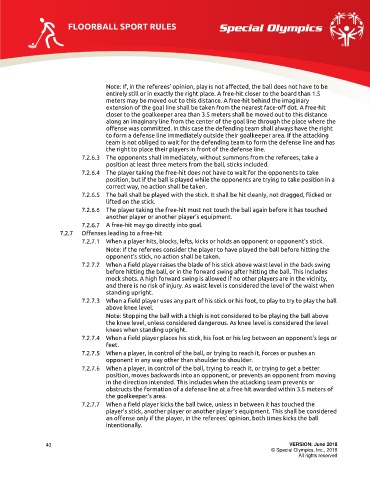Page 295 - Revised Unified Sports Curriculum electronic version Rev. 8.1_2
P. 295
FLOORBALL SPORT RULES
Note: If, in the referees’ opinion, play is not affected, the ball does not have to be
entirely still or in exactly the right place. A free-hit closer to the board than 1.5
meters may be moved out to this distance. A free-hit behind the imaginary
extension of the goal line shall be taken from the nearest face-off dot. A free-hit
closer to the goalkeeper area than 3.5 meters shall be moved out to this distance
along an imaginary line from the center of the goal line through the place where the
offense was committed. In this case the defending team shall always have the right
to form a defense line immediately outside their goalkeeper area. If the attacking
team is not obliged to wait for the defending team to form the defense line and has
the right to place their players in front of the defense line.
The opponents shall immediately, without summons from the referees, take a
position at least three meters from the ball, sticks included.
The player taking the free-hit does not have to wait for the opponents to take
position, but if the ball is played while the opponents are trying to take position in a
correct way, no action shall be taken.
The ball shall be played with the stick. It shall be hit cleanly, not dragged, flicked or
lifted on the stick.
The player taking the free-hit must not touch the ball again before it has touched
another player or another player’s equipment.
A free-hit may go directly into goal.
Offenses leading to a free-hit
When a player hits, blocks, lefts, kicks or holds an opponent or opponent’s stick.
Note: If the referees consider the player to have played the ball before hitting the
opponent’s stick, no action shall be taken.
When a field player raises the blade of his stick above waist level in the back swing
before hitting the ball, or in the forward swing after hitting the ball. This includes
mock shots. A high forward swing is allowed if no other players are in the vicinity,
and there is no risk of injury. As waist level is considered the level of the waist when
standing upright.
When a field player uses any part of his stick or his foot, to play to try to play the ball
above knee level.
Note: Stopping the ball with a thigh is not considered to be playing the ball above
the knee level, unless considered dangerous. As knee level is considered the level
knees when standing upright.
When a field player places his stick, his foot or his leg between an opponent’s legs or
feet.
When a player, in control of the ball, or trying to reach it, forces or pushes an
opponent in any way other than shoulder to shoulder.
When a player, in control of the ball, trying to reach it, or trying to get a better
position, moves backwards into an opponent, or prevents an opponent from moving
in the direction intended. This includes when the attacking team prevents or
obstructs the formation of a defense line at a free hit awarded within 3.5 meters of
the goalkeeper’s area.
When a field player kicks the ball twice, unless in between it has touched the
player’s stick, another player or another player’s equipment. This shall be considered
an offense only if the player, in the referees’ opinion, both times kicks the ball
intentionally.
43 VERSION: June 2018
© Special Olympics, Inc., 2018
All rights reserved

